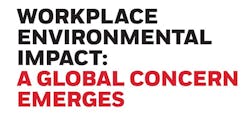PRESS RELEASE
- More than half of surveyed U.S. office workers (53%) are very or extremely worried about their building's indoor air quality – nearly twice the 28% who expressed concern in 2022’s results;
- Two-thirds (67%) of surveyed U.S. office workers strongly agree that the quality of the air they breathe has a direct impact on their health and well-being.
ATLANTA, February 22, 2023 – In a new survey of U.S. office workers, nearly all respondents (95%) say their expectations for improved indoor air quality (IAQ) have increased in the past three years, according to a report released today by Honeywell (Nasdaq: HON). Honeywell’s third annual Healthy Buildings Survey recently queried 2,500 office workers in buildings with 500-plus workers in Germany, India, the Middle East, the United Kingdom, and the United States.
The survey sheds light on the impact of buildings on both occupant well-being and the environment.
A substantial majority (77%) of U.S. respondents feel it’s extremely or very important that their employer or building manager keep them informed of their building's IAQ – a 22-point leap from Honeywell’s 2022 Healthy Buildings survey. In fact, an overwhelming majority of surveyed U.S. office workers (88%) agree that limiting investment in IAQ technology shows a low commitment to employee safety and well-being.
Nearly all U.S. respondents (98%) would take at least one of the following actions if their employer didn't put measures in place to maintain a healthy indoor environment:
- Speak with a supervisor or leadership (60%);
- Request to work remotely (40%);
- Rally other workers and raise the issue (34%);
- Look for another job (21%).
The U.S. workforce recognizes the benefits of good IAQ on their health and well-being: 76% of respondents believe it contributes a lot to their productivity; 61% say it contributes to better overall physical health; and 58% believe it contributes to better overall mental health, including mood and general functioning at work – a 10-point increase over last year’s results.
This year’s survey posed questions for the first time about making buildings more sustainable, revealing that 34% of U.S. respondents feel their employer should be prioritizing both better IAQ and a reducing their building’s carbon footprint. Nearly half (46%) of those surveyed feel their employer should prioritize improving IAQ in their building, while 20% prefer that they prioritize reducing the building’s carbon emissions.
A resounding majority of surveyed U.S. office workers (81%) believe it’s extremely or very important that their employer or office building manager actively take steps to reduce their building's carbon emissions. An even larger number of respondents (91%) would be willing to give up at least one job perk or benefit if it meant the funds would be reinvested in reducing the environmental impact of their building. Most notably, 28% of those surveyed said they would sacrifice part of their salary or bonus – slightly more than the 26% global average.
“The expectation for improved IAQ among U.S. office workers has significantly increased in the past three years,” said Manish Sharma, vice president and general manager of Sustainable Buildings, Honeywell. “As employees become more aware of IAQ’s effects on their well-being, as well as their building’s impact on the environment, it's crucial for employers and building managers to understand that these two priorities need no longer be viewed as mutually exclusive.”
Honeywell's ready now Healthy Buildings solutions can help improve occupant well-being, meet energy efficiency goals and, importantly, change the way occupants experience a building. Surveyed workers’ concerns about the environmental impact of their workplace may be buoyed by the emphasis organizations are placing on sustainability as detailed in the 1Q 2023 Honeywell Environmental Sustainability Index, a quarterly survey of business leaders directly involved in their organization’s environmental sustainability initiatives measuring key trends pertaining to global efforts in climate change mitigation and other sustainability initiatives.
Seventy-one percent of organizations surveyed in the second release of Honeywell Environmental Sustainability Index ranked sustainability as one of their top five priorities (highest percentage) and 63% of surveyed organizations said energy evolution and efficiency are a top priority. The Index shows organizations are increasingly taking a balanced approach to environmental solutions, embracing more technological solutions alongside process changes.
To read the full report, please click here.
Methodology
The Honeywell Survey was conducted by Wakefield Research (www.wakefieldresearch.com) among 2,500 workers in buildings of 500-plus workers across five markets – Germany, India, the Middle East, the United Kingdom and the United States – between January 12 and January 22, 2023, using an email invitation and an online form. The data has been weighted. Results of any sample are subject to sampling variation. The magnitude of the variation is measurable and is affected by the number of interviews and the level of the percentages expressing the results. For the interviews conducted in this particular study, the chances are 95 in 100 that a survey result does not vary, plus or minus, by more than 4.4 percentage points from the result that would be obtained in each market if interviews had been conducted with all persons in the universe represented by the sample.
About Honeywell Building Technologies
Honeywell Building Technologies (HBT) is transforming the way every building operates to help improve the quality of life. We are a leading building controls company with operations in more than 75 countries supported by a global channel partner network. Commercial building owners and operators use our hardware, software and analytics to help create safe, efficient and productive facilities. Our solutions and services are used in more than 10 million buildings worldwide.
Honeywell (www.honeywell.com) delivers industry specific solutions that include aerospace products and services; control technologies for buildings and industry; and performance materials globally. Our technologies help aircraft, buildings, manufacturing plants, supply chains, and workers become more connected to make our world smarter, safer, and more sustainable. For more news and information on Honeywell, please visit www.honeywell.com/newsroom.
##########
Media Contacts
Honeywell, Telleen Gegner, [email protected]; FINN Partners, Meagan Meldrim, [email protected].
##########
Disclaimer: The information presented in this document is intended solely for informational purposes and not as advice or recommendations for any particular action or investment. The information should not be relied upon, in whole or in part, as the basis for decision-making or investment purposes. The document and its contents are not guaranteed as to accuracy or completeness and are provided on an “as is” basis. Use of this information is at your own risk. Honeywell disclaims all warranties as to the accuracy, completeness, or adequacy of such information and shall have no liability for errors, omissions, or inadequacies in such information. This document includes opinions which should not be construed as statements of fact. Any opinions expressed herein are subject to change without notice. Any forecasts and forward-looking statements are directional indicators, are not predictions of future events, and do not in any way reflect expectations for (or actual) Honeywell operational or financial performance. Any forecasts and forward-looking statements represent our current judgment and are subject to risks and uncertainties that could cause actual results to differ materially. You are cautioned not to place undue reliance on these forecasts and forward-looking statements, which reflect our opinions only as of the date of publication for this document. Honeywell is not obligated to revise or publicly release the results of any revision to these forecasts and forwardlooking statements in light of new information or future events.
Media Contacts: Honeywell FINN Partners Telleen Gegner Meagan Meldrim (404) 545-6132 (616) 970-2177 [email protected] [email protected]










